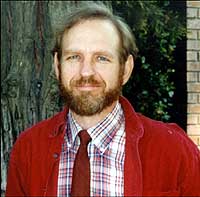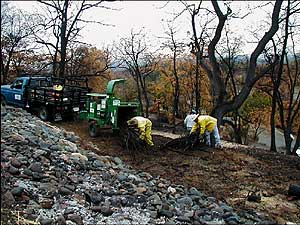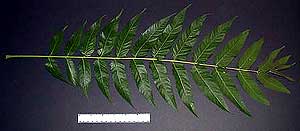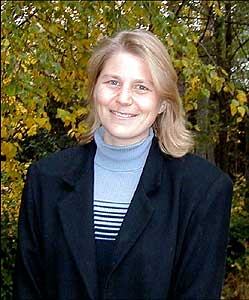|
In This Issue:
This issue of the Conservation Almanac is being funded in part by grants from the
State Water Resources Control Board, NRCS EQIP, and the Department of Conservation
Oregon Fire Rehabilitation Efforts
Trinity County RCD hosted a community meeting for all affected private non-industrial landowners in October to discuss rehabilitation work. The RCD has limited funds for sediment reduction work in Weaver Creek basin from the Bureau of Reclamation. The meeting focused on immediate needs and then an informal discussion with landowners about longer-term rehabilitation possibilities took place.
The fire burned approximately 455 acres of private non-industrial lands affecting 60 landowners.The RCD is working with Congressman Herger's office on a proposal to allocate Emergency Forestry Incentive Program funds for replanting these private lands. Additional funds have been applied for from California Department of Fish and Game for private lands, and the Bureau of Land Management for work on their lands.
Several agencies are working to reduce the impacts of the fire. This fire had multiple ownerships including US Forest Service, Bureau of Land Management, Sierra Pacific Industries, and many private parcels. The US Forest Service has completed a Burned Area Emergency Rehabilitation (BAER) Plan. Dozer and hand lines have been mulched with straw. A CDF Conservation Camp Crew has implemented rehabilitation work on the Moon Lee Ditch. Bureau of Land Management, which had about 150 affected acres, is planning to salvage about 80 acres with associated restoration including some seeding and mulching of steeper slopes and gullies.
CalTrans removed hazard trees in the right-of-way along Highway 299 to protect the highway from falling trees and cleared out drainage areas, as well as replacing culverts where needed. It is expected that the amount of water that runs off the landscape during winter storms will be significantly increased due to the fire.
Return to this Issue's Index |
Community Based Wildfire Grants Awarded
Members of the Trinity County Fire Safe Council applied for, and received, funds from the California Fire Safe Council's Community-Based Wildfire Prevention grant program. This program had about $3.8 million dollars available for projects with a focus on hazardous fuels reduction, public and community education, and project planning and capacity building that will reduce the fire threat in the wildland-urban interface.
The wildland-urban interface is the area where residences and forested areas overlap. Wildland-urban interface fire issues have grown from a local to a national concern over the past 15 years. The 2000 and 2001 fire seasons demonstrated the vulnerability of people living at risk throughout the western U.S. The number of people living in areas with high risk of wildfire is expected to continue to grow in California.
Post Mountain Public Utility District and the Post Mountain Volunteer Fire Department received a $50,000 grant for constructing shaded fuel breaks along 26 miles of private road rights-of-way. This project will be implemented with the Watershed Research and Training Center. Trees and brush will be chipped into mulch or made into fence posts or poles where feasible. This grant includes the purchase of a chipper for the use of the Volunteer Fire Department.
Trinity County RCD was awarded two grants of $50,000. One is to implement a mile of shaded fuel break on private land above Timber Ridge in Weaverville that will tie into the shaded fuel break being planned by the Bureau of Land Management. The second grant is to implement defensible space projects with landowners in the B-Bar-K and Jordan Roads area near Douglas City.
The Southern Trinity region had two proposals funded—a shaded fuel break implementation project and a proposal to provide outreach and education support.
Return to this Issue's Index
Post Mountain Fuels
Reduction Project
About 30 people attended a meeting at the Post Mountain Volunteer Fire Department Fire Hall on October 8th to discuss a fuels reduction demonstration project on private lands in this community. Many others have expressed an interest in participating in this critical project.
Large fires have occurred in the Post Mountain area in the past, and, despite all efforts, will probably occur again. The mix of residential development, timberlands, hot summer weather and limited road access, make fire and fuel management an important concern of area residents and landowners. California Department of Forestry and Fire Protection has indicated that this is a community at a very high risk for catastrophic fire and that fuels reduction efforts around homes, as well as fuel breaks, are highly recommended. The Trinity County Fire Safe Council's community fire planning process has identified Post Mountain as one of the highest priority areas for fuels reduction efforts.
The RCD has funding from the State Water Resources Control Board's Prop 204 for planning and implementing this fuels reduction project. The RCD, in conjunction with Post Mountain Volunteer Fire Department and Post Mountain Public Utility District, would like to work with landowners to implement the most effective treatments possible for the funding available. This project will assist landowners in implementing defensible space zones around their homes and chipping the material to provide a ground mulch.
We are looking forward to working with the homeowners in the Post Mountain community to reduce the risk of catastrophic fire.
|
Watershed Coordination Activities
Since March of this year, the Trinity County Resource Conservation District has been actively involved in Watershed Coordination in the Trinity River and the South Fork Trinity River Watersheds with funding from the California Department of Conservation. These grants have enabled us to play an important role in assisting stakeholders in developing watershed restoration priorities and in seeking the funds to implement them.
South Fork Trinity River Watershed
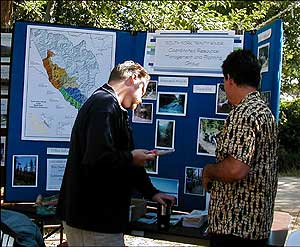 |
South Fork CRMP Booth at Salmon Festival
The RCD continues to participate in the South Fork Coordinated Resource Management Planning Group. South Fork CRMP efforts currently include the development of a monitoring program to assist landowners and land managers; developing road and erosion control workshops; coordinating partners in securing funding for restoration work in the South Fork; and meeting with individual landowners to discuss concerns about the watershed.
The South Fork CRMP hosted a booth at the Trinity County Fair and the Salmon Festival, which displayed pictures of work being done in the watershed and a watershed survey for landowners to complete to give us a better understanding of how we can serve our constituents and get people involved.
The District's watershed coordinator has submitted 12 proposals to benefit the South Fork Trinity River Watershed and its landowners. These proposals include the South Fork Trinity River Watershed Restoration Project submitted to the State Water Resources Control Board's 319(h) program for $450,000.
Trinity River Watershed
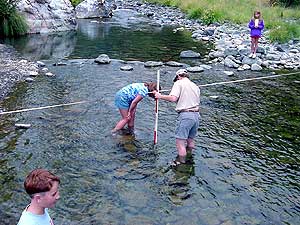 |
Bar 717 Environmental Camp
The RCD continues to coordinate the efforts of the Trinity River Watershed Coordination Group. A goal of this Group is to prioritize actions that support the Trinity River Record of Decision. This is critical in assuring that the program is fully funded from all available sources and receives support from stakeholders. Other important parts of watershed coordination include meeting with individual landowners to discuss concerns and bringing awareness of the watershed to the classroom. The Watershed Coordinator taught 70 6th grade children at the Bar 717 Environmental Camp in September.
Since March, the District's Watershed Coordinator has submitted 21 proposals for restoration projects that will benefit the Trinity River Watershed. This includes two proposals to address sediment reduction from the Oregon Fire in Weaverville, which were submitted to the Department of Fish and Game and to the Bureau of Land Management.
Return to this Issue's Index
Frequently Asked Questions:
Trinity River Fisheries
Restoration Program
Q: Is it true that riparian willow trees will be cut down to open up the gravel bars along the river? The RCD asked me to retain all the trees on my stream-front property.
A: This is true. On large unregulated rivers, such as the pre-dam Trinity River, large open gravel bars did not have vegetation near the water's edge. Instead, the vegetation flourished further back on the floodplains away from the scouring power of the large river. These open gravel bars are needed to maintain a healthy river. The ecological needs are different on smaller tributary streams, such as those on which the RCD often works with landowners. On the smaller streams, large trees near the water's edge throughout the stream corridor are a natural ecosystem component, and serve to stabilize the streambanks and provide shade to keep the stream cool and provide cover for the fish.
Q: By clearing out the trees on the gravel bars, will you increase flooding? When?
A: By itself, opening up gravel bars may actually decrease the risk of flooding. However, the restoration plan calls for higher dam releases from late April to late June. The highest of these scheduled releases is still only about 11% of the highest recorded pre-dam floods. The higher flows will cause flooding on a few of the properties inside the 100-year floodplain. At least one house and several outbuildings and mobile homes are expected to be affected significantly. The federal government will work with affected landowners prior to releasing the higher flows. Four bridges— Bucktail, Poker Bar, Salt Flat, Steel Bridge Rd. at the Treadwell property)—will be modified to accommodate modified flows.
Q: Will these projects cause the Trinity River to get muddy for a long time? Doesn't this hurt the fish?
A: Each project will be designed and monitored to minimize impacts on the river, especially by sediment. Restoration will cause a short-term disturbance and reduction of water clarity. It is likely that the clarity of the river immediately downstream from a project will be visibly reduced for one to two days. The long-term benefits to fish far outweigh any possible short-term impacts.
More FAQs in the next newsletter….
|
A Current View of the
Trinity River and Restoration
By Brandt Gutermuth,
BLM Trinity River Coordinator
For more than twenty years scientists in the Trinity Basin have been working to determine what has resulted in the 90% decline in Trinity River salmon since the 1962 closure of Trinity Dam. While difficult to pinpoint a single reason, it is clear that the form of the historical Trinity, in which the salmon evolved and developed, has changed dramatically since the dam. The unregulated Trinity River was 109 miles longer than the river today and meandered along a broad floodplain. Despite poor land management prior to the dam (hydraulic mining, substandard logging and road building practices, etc.), the river was occasionally scoured with large floods that reset the river landscape, removed trees, opened the floodplain, and cleared the gravel of fine sediment. These were the life-restoring flows that maintained the river. Today, our historical Trinity River water is spread between many ”good” uses; Farming in the Central Valley, power, and fish. The beautiful Trinity River now is
shorter, more consistent in morphology, and entrenched between river berms. It is now believed that a general lack of slow water habitat needed for young salmonid development may be limiting Trinity River salmonid production.
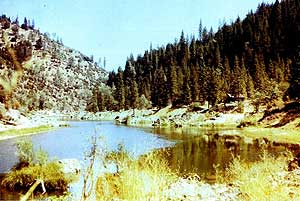 |
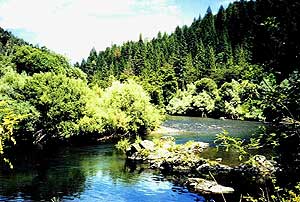 |
Trinity River--Pre and Post Dam
As the new Bureau of Land Management (BLM) Trinity River Coordinator (stationed in Weaverville from the Redding Field Office), I hope that I can bring my past fishery experience to bear upon the Trinity River. I am hopeful...and excited that Trinity County is at a turning point in its coordinated effort to restore the Trinity River. In fact, it was the Department of Interior's December 2000 Record of Decision (ROD) to adopt a relatively specific plan of river recovery, the Trinity River Restoration Plan, that attracted me to work in Weaverville on Trinity River restoration. Of course I was very disappointed when I saw implementation of the ROD slowed by legal challenges from Central Valley Water and Power interests – but I am becoming heartened again by recent events. Recently, Clean Water Act water quality standards have been used as justification for the allocation of needed water in Oregon and California. These instances, and the new “Trinity River Total Maximum Daily Load for
Sediment,” are prime cases where flow increases (to ROD specifications for the Trinity River) are just and defensible. Loosely speaking, the ROD calls for “48% of the water for Trinity River fish and 52% for the Central Valley.”
To observe the River's need for water yourself, go to the Trinity River at the mouth of the North Fork Trinity River (Helena; from the Hwy 299 bridge), and view how river flow determines the river form. Downstream from here, the mainstem Trinity has enough water (generally) to maintain its natural form and function. The river can be seen to meander more below the confluence of the North Fork, and to be made up of a greater amount of scoured point and alternating bars (needed slow water habitat for salmonids) than above. Similarly, a comparison at another Trinity River location, closer to the Dam, over time indicates a tremendous increase in river bank vegetation and a reduction in slow-water river-edge habitats. If people are rational (and politics fair), the river will receive increased flows. Since much of the annual flow allocated in the ROD depends on the wetness of the year (e.g., the river gets more water in a wet year than a dry year), we need to be prepared to make the most of
our water in a good year! Though the ROD outlines a general set of measures for implementation, (e.g., supply clean gravel for spawning and rearing, provide specific river flows depending on the time of year and available water, and prepare “bank rehabilitation” projects for jump starting the addition of juvenile fish habitat), we will not secure all the water that the river historically held. We will have to use our water wisely.
In the next issue of the Conservation Almanac Brandt will discuss his recommendations on how we can efficiently implement necessary restoration work. Brandt can be reached at (530) 623-5104.
Return to this Issue's Index
Noxious Weeds to Watch in Trinity County
Tree of Heaven (Ailanthus altissima)
An invasive plant is defined as a plant that grows aggressively, spreads and displaces native plants in an ecosystem. Tree-of-heaven, a native to central China, fits all three criteria. Ailanthus grows rapidly, achieving its mature height of 90 feet and diameter of 3 feet in little more than a decade. In addition to its fast growth rate, ailanthus is able to grow under very harsh conditions and to produce an abundant seed crop. The large, compound leaves of this deciduous tree are one to four feet in length and comprised of eleven to twenty-five leaflets. Leaves are reddish when they unfurl in spring, but quickly turn bright green, especially when compared with the muted greens of California native trees and shrubs. Ailanthus has smooth stems with pale grey bark that gets rougher with age and resembles cantaloupe rind on older trees.
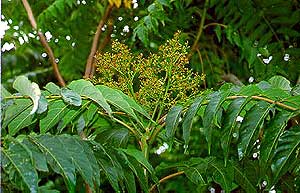 |
Tree-of-heaven can become a problem, because the wood is soft and weak. A fast growing tree with weak wood is a bad combination since they tend to break easily in snow, ice, and windstorms. Additionally, tree-of-heaven is useless for structural wood, and is not even desirable for firewood or wildlife.
The seeds produced by tree-of-heaven are shaped like a wing with the ends twisted like a propeller. The wind can carry the seeds quite a distance. A pioneer species, it will crowd out other species of trees. The tree establishes forest stands quickly, because each tree produces root sprouts that grow in concentric rings around the “mother” plant. Once established, it tends to form impenetrable thickets. Ailanthus also produces toxins that prevent the establishment of other plant species. The root system can also damage sewage systems and foundations of buildings.
Ailanthus was introduced to the east coast by a gardener in Philadelphia. In California, the Chinese, who came here during the Gold Rush, brought it with them. The tree-of-heaven was culturally and economically significant to the Chinese, because it is a food source of silkworms. Since then, it has been used as an ornamental, especially in harsh urban settings, because of its ability to grow in barren areas.
Ailanthus is an extremely difficult tree to remove from the landscape once it is established. Tree-of-heaven does have at least one weakness. It doesn't tolerate shade well, so heavily wooded areas have little problem with it. Tree-of-heaven is very difficult to remove once it has established a taproot. It has persisted in certain areas despite cutting, burning and herbiciding. Therefore, seedlings should be removed by hand as early as possible, preferably when the soil is moist to insure removal of the entire taproot. Larger plants should be cut. Two cuttings a year may be necessary, once in the early growing season and once in the late growing season. Initially, this will not kill the plant. It will vigorously resprout from the roots, but seed production will be prevented and the plants will not grow as tall. If continued over a period of several years, cutting during the growing season stresses the plants and may eventually kill them.
Return to this Issue's Index |
Trinity County Salmon Festival
Nearly 900 people attended the 3rd annual Salmon Festival on October 6th. The day began with a 5K Fun Run/Walk at 9am. The overall finisher was Sean Cahill from Weaverville, with a time of 17 min 51 sec. The top female finisher was Kazumi Nigro from Shasta Lake with a time of 20 min 18 sec.
At the Festival, kids had their pick of nearly a dozen activities ranging from huge salmon storytelling tents to an interactive game where kids took on the role of a salmon egg and faced several obstacles on their journey to adulthood.
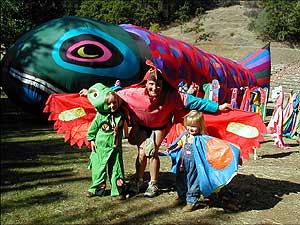 |
Salmon Tent and Costumes
Musicians including blues artist George Griffin, Kuimba, and Buddy Hazard entertained everyone with great music. Various community groups, educational booths, and food and drink vendors also contributed to the event's success. Free snacks for children were provided by one of the sponsors, Frontier Nutrition Project. Trinity County Arts Council (TCAC) and the Trinity County Resource Conservation District (TCRCD) also co-sponsored the event.
If you are interested in making next year's Festival even bigger and better, please contact the TCAC at 623-2760 or the TCRCD at 623-6004.
|
Lewiston Trails Group Formed
The Lewiston Trails Group met at Mama's Place in Lewiston on Thursday, October 4th to plan their first project. There was a great turnout with over 20 interested residents attending who showed enthusiasm for developing a trail system around Lewiston, similar to the one developed over the past several years in Weaverville. The Group's first priority is to develop a trail from Grass Valley Creek and Hamilton Ponds to the Arena in Lewiston Park. The objective of this project is to provide access from Wellock Road to Lewiston Park for pedestrians, equestrians, and bicyclists. The group agreed that gaining access to public lands (BLM, Department of Water Resources, County, etc.) would be much easier than obtaining access to private lands. With this in mind, the group decided that the project may fall into several phases. The group plans to tackle small projects each month on a workday with volunteers doing agreed upon trail work so that progress can be seen immediately. The first
project is scheduled for Saturday, October 27 to clear trail at the end of Wellock Road. This way success can be exhibited along the way that may help with other phases of the project.
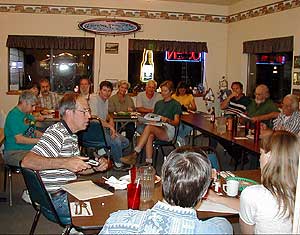 |
Chris Erikson has talked with the Department of Water Resources (DWR) and obtained permission for the group to clear the DWR road from Wellock Road to the Hamilton Ponds. Chris mentioned that with the process that is going on with the Trinity River Restoration Project, it is a great time to get involved in the planning for any river-front trails along BLM lands.
Another project includes a trail around Lewiston Lake on primarily US Forest Service lands. A representative from the Forest Service is scheduled to be at the next Lewiston Trails Group meeting.
Other potential projects include: access from Lowden Meadow to the Bucktail River Access, and from Salt Flat Bridge to Rush Creek Road.
The Lewiston Trail Group currently plans to meet on the 2nd Wednesday of each month at 7pm at Mama's. For more information contact Chris Erikson at 778-0306 or the RC&D Council at (530) 623-2009 ext. 3.
Return to this Issue's Index |
District Manager's Corner
by Pat Frost
Summer and early fall seem to be a time for community gatherings. It is a time for reunions, family picnics and homecomings. For the District it is a time for get-togethers, too. We were able to meet many of you at the Trinity County Fair and the Third Annual Salmon Festival. And I had the good fortune to go to Bar 717 Ranch near Hyampom with the Sixth Grade Class from Weaverville Elementary School.
 |
TCRCD Board Member, Patrick Truman, volunteers at the children's "Go Fish!"
A central part of the District's mission is to provide education to our communities. The County Fair, Salmon Festival and Sixth Grade camp are great ways for us to reach out to you. I also learned that these get-togethers are just as important for us to learn from you. I know that I came away from each event with new ideas. Fair patrons told me about drought years on their creeks, the behavior of wildfires and how they have overcome adversity.
The Salmon Festival taught me how rewarding it is to see the sparkle in the eyes of a four-year old, who knows the answer to the question “What does a salmon eat?” and then gets to “Go Fish” for a special prize. Four days with 70 sixth graders taught me a great deal. I was truly impressed with their knowledge of the natural world around them. They reminded me that children brought up in Trinity County have streams and mountains as their playgrounds and that they are blessed with parents, who teach them about the importance of good stewardship.
I encourage you to join us the next time you see an announcement for a community watershed meeting or a workshop. Better yet, give us a call and invite us to come speak to your community or organization. We can't learn from each other, if we don't know each other.
Return to this Issue's Index
Featured Employee
Meet Cindy Blanchard, the District's New Fiscal Manager!
Cindy joined the RCD on September 10 and brings with her a fresh perspective and plenty of enthusiasm!
The daughter of Charley and Susan Fitch, Cindy grew up in Weaverville, graduating from Trinity High School in 1990. After marrying her high school sweetheart, Byron Blanchard, she studied Business and Accounting at Monterey Peninsula Community College.
Cindy and Byron returned to Trinity County to raise their now 6-year-old twins, Chad and Steven. Cindy enjoys hiking, gardening, photography and spending quality time with her family. She can't think of a better place than Trinity County to do all that she loves. And, of course, that includes numbers…Cindy worked in the Trinity County Auditor's Office for five years before joining the staff at the RCD. She claims to have always found numbers and mathematical problem solving irresistible. Although Cindy believes her aptitude for numbers was apparent as a youngster, she is quick to say her high school algebra teacher, Mr. Ode, might not agree! She adds with a smirk, " that's when letters started appearing in mathematical computations!"
Cindy's outgoing personality and fervent approach to number crunching is a welcome addition to the RCD.
|
Return to the Trinity County RCD Home Page
|




